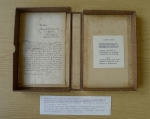 Donations to libraries come in all sizes, from a single book donated by the author, to large collections which make you get out a tape measure to make sure you have the space. They all have a place in the history and development of a collection, and even a subject field. The donation in 1944 by Robert Stewart Whipple (1871-1953) of his scientific instruments and books to the University has been viewed as “… an essential element in the establishment of the history of science as an academic discipline in Cambridge”1 . Whipple’s original donation consisted of 1089 books covering subjects such as microscopy, optics, astronomy, physics and of course, scientific instruments. A small exhibition took place in November 1944 showing some of the key items in the collection, both instruments and books, with a write up appearing in ‘Engineering’. The books displayed, and therefore mentioned in the article, included:
Donations to libraries come in all sizes, from a single book donated by the author, to large collections which make you get out a tape measure to make sure you have the space. They all have a place in the history and development of a collection, and even a subject field. The donation in 1944 by Robert Stewart Whipple (1871-1953) of his scientific instruments and books to the University has been viewed as “… an essential element in the establishment of the history of science as an academic discipline in Cambridge”1 . Whipple’s original donation consisted of 1089 books covering subjects such as microscopy, optics, astronomy, physics and of course, scientific instruments. A small exhibition took place in November 1944 showing some of the key items in the collection, both instruments and books, with a write up appearing in ‘Engineering’. The books displayed, and therefore mentioned in the article, included:
- The life of John Dollond by John Kelly, signed by Michael Faraday (STORE 20:23)
- Tracts consisting of observations about the saltness of the sea by Robert Boyle, previously owned and inscribed by Isaac Newton (STORE C:20)
- Historiae coelestis libri duo by John Flamsteed, previously owned by Stephen Peter Rigaud ( 1774 – 1839) founder of the Ashmolean Society and professor of astronomy at oxford (STORE 57:9)
These are just three of the treasures that help make the Whipple Collection an amazing resource for anyone interested in the history of science.
References:
- Silvia de Renzi. Between the market and the academy: Robert whipple (1871-1953) as a collector of science books (REF FILE 14 B:26)
- The Whipple Collection of Instruments and Books. Reprint from “Engineering” Nov. 10 1944 and Mar. 2 & 23, 1945 (REF FILE 35 B:8)
Dawn






